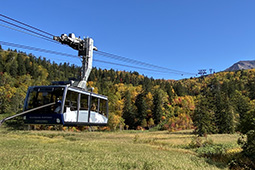September 2022
- English
- 日本語
The Autumn Leaves of Mt. Asahidake, Hokkaido

The Aleutian avens turn bright red in autumn 
The slopes of Mt. Asahidake viewed from the ropeway in autumn

The Daisetsuzan Asahidake Ropeway connects Sanroku Station at an altitude of 1,100 meters above sea level with Sugatami Station at 1,600 meters in around 10 minutes

In mid-September, when the lingering summer heat is still intense across most of Japan, the broad-leaved forests and alpine plants of Mt. Asahidake on the northernmost main island of Hokkaido begin to turn red, the first in Japan to do so.

Daisetsuzan National Park, located in central Hokkaido, is known as the first place in Japan where the leaves start to change color. On the slopes of Mt. Asahidake (an active volcano with a height of 2,291 meters above sea level), the tallest peak of the Daisetsuzan mountain range that comprises a series of 2,000-meter-high mountains, the leaves of the Sorbus matsumurana and Aleutian avensi begin to turn yellow and red from around mid-September. Visitors can enjoy the autumn colors of the alpine plants at their feet near the Sugatami area 1,600 meters up, a place which is reached by ropeway.
“Due to Hokkaido’s high latitude, points at 1,600 meters above sea level are above the tree line (the edge of the habitat where trees can grow). That is why there are barely any tall trees halfway up Mt. Asahidake. When the alpine plants at your feet change color one after another in autumn, the ground seems to be carpeted in red and yellow,” explains Wilcock Kanako of the Higashikawa Tourism Association. “The magnificence of Mt. Asahidake and the autumn leaves at its base is a scene that cannot be enjoyed anywhere else. In the early morning, you can sometimes see a dramatic and magnificent view, passing through a sea of clouds on the ropeway.”
Among the alpine plants that grow in clusters mid-slope on Mt. Asahidake are Aleutian avens (Geum pentapetalum). In autumn they turn bright red all at once, completely changing the landscape. In summer, the Aleutian avens produce pretty white flowers, and together with the flowers of the other alpine plants visitors can see a paradise-like scene that is referred to as a “flower garden in the sky.” The Ainu people, who have lived in Hokkaido since ancient times, cherish this place and call it Kamui Mintara, meaning “the garden where gods dwell.”
The Daisetsuzan Asahidake Ropeway, which operates year-round, takes visitors from Sanroku Station at a point 1,100 meters above sea level to Sugatami Station at 1,600 meters in around 10 minutes. From Sugatami Station there is a trekking course around 1.7 kilometers long that takes about an hour to go around.

“I recommend going to the south side of the course so that you can enjoy strolling while looking at Mt. Asahidake in front of you,” says Wilcock. “Around the Sugatami Pond on the tour course, you get an up-close view of the fumaroles, vents in the ground from which steam rises up with roaring sounds like a jet engine. You can really feel the power of the living earth there,” says Wilcock.
The mid-slope of Mt. Asahidake is a place of contrast, with its mountain form emitting plumes of smoke in places, interwoven with the red carpet of Aleutian avens. It is a beautiful autumn scene that is unique to this area.
Just when the leaves are about to change color, the first snow falls. At around the end of September, it is sometimes possible for visitors to enjoy the sight of autumn leaves and the first snow on the mountain at the same time.
* This small alpine shrub grows to around 10 centimeters in height.

